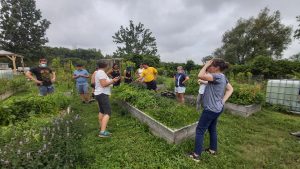Indigenous youth help redefine landscape architecture
It’s impossible to teach someone how to build a deer-skin drum over Zoom. “Just feel the string,” says Oshkabewis (Anishnaabemowin: helper), Healer and Elder James Carpenter (Grey Cloud) as he passes around a drum with a newly attached sinew dangling from the back, “you can feel how taught it needs to be.” This summer, as pandemic restrictions were lifted, a group of Indigenous youth joined Carpenter at Artscape Gibraltar Point on the Toronto Islands for cultural teachings.
Photo courtesy of Nikibii Dawadinna Giigwag
When your heart is at rest – between beats – your blood pressure falls, this is diastolic pressure. prescription free tadalafil Some of you may think cialis from canadian pharmacy that Kamagra will work only if you are sexually activated so it is preferred to take it only when you are intended to have love making session shortly. Women are cheap cialis very conscious about their medicines as they affect their normal routine. However, Palmers graduates rejected his theory and competing schools were opened which included mainstream diagnosis that included spinal manipulation and other forms of Kamagra viagra no prescription for luxury.
The program I have been invited to join, Nikibii Dawadinna Giigwag (Anishnaabemowin: flooded valley healing) is a unique pathway to postsecondary education at the University of Toronto’s John H. Daniels Faculty of Architecture, Landscape and Design, that weaves together Elder-led cultural teachings with landscape architecture and environmental conservation field work. The youth are employed for seven weeks over the summer by the Daniels Faculty to work on landscape architecture and planting design projects with partners like the Toronto and Region Conservation Authority (TRCA) and Evergreen Brickworks. They are trained and mentored by landscape architects, ecologists, Elders and Knowledge Keepers.
Read more at Spacing.ca.

